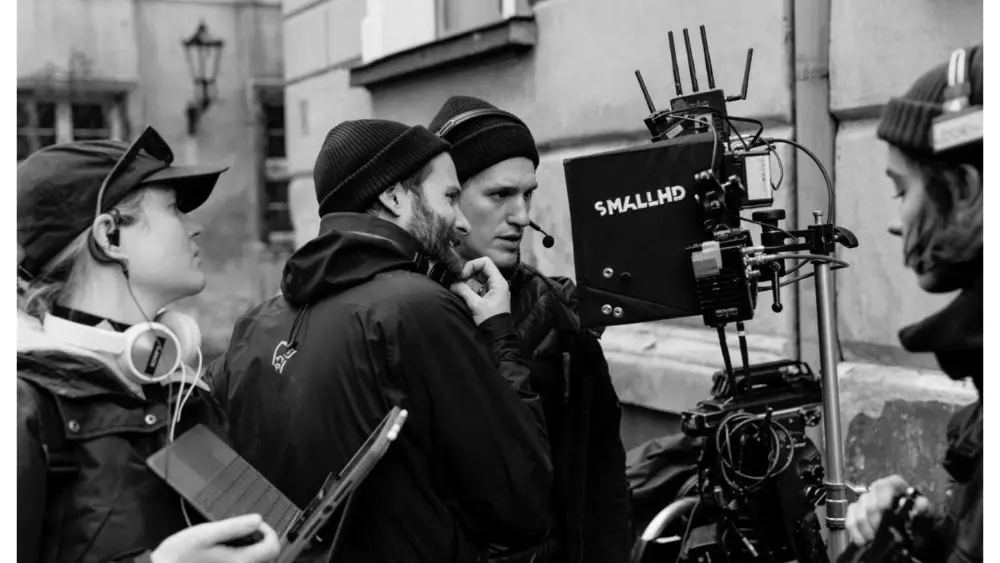When Polish cinematographer Michal Dimek first read the script for “Girl with a Needle,” which won this year’s Camerimage Main Prize, he immediately had a scene in his head. It is a stark and shadowy image of a dilapidated slum in Denmark. Workers bend over creaking machinery during World War I.
He saw a classic screenshot composition that framed a crumbling, claustrophobic space in which desperate people were trapped.
“It was amazing and powerful. It was like the best script I’ve ever read,” Dimek says. He says he knew instantly that the film had to be in black and white. “We wanted to build a time machine. The only thing we know about that time is black-and-white photographs, so we had to capture them.”
After two years of preparation, as the production grew into projects in Denmark, Sweden, and Poland, it was decided to employ Leica Hugo lenses to create the distortions of old glass and keep true to the early 20th century archival images. says Dymek. The lives of workers ruled by captains in the industrial age.
And the gruesome setting created would naturally lead to a story about a serial killer who promises redemption, no matter the price, to women with babies they can’t afford to have.
The Girl with the Needle, directed by Magnus von Horn and written by Line Langebek-Knudsen, is based on true events from one of the darkest chapters of modern Danish history, and follows the story of Caroline, who works in a textile factory. In the story, things spiral and things get more and more serious. She fights hard to make her life better.

“Girl with a needle”
Courtesy of Lukasz Baku
Dymek worked with von Horn on 2020’s “Sweat,” a tale of obsession and social media myth-making, and said the two were once again working together to convey the idea of looming eerie forces. He knew to find a visual language, he says.
To capture the dark, decaying world of Caroline, played with astonishing quiet power by Vic Carmen Sonne, Dimek looked not far from the Lodz film school where she studied. There, he learned that unlike today’s clean, streamlined Copenhagen, the Danish city still had “everything bent and broken and falling apart” as it was 100 years ago.
For the dark, stuffy factory interior, the tenement where Caroline lives, and the room above the candy shop where the evil identity draws her, Dymek and Van Horn decided to build a set that gave them complete control over the space. . “It had to be a cramped place, where people were oppressed and couldn’t move, and there was no light or air,” says the cinematographer.
Shooting with the Arri Mini LF using a color sensor allows you to use filters on your black and white images to manipulate skin tones and the shadow spectrum, Dymek says.
They also wanted the world to be “uncomfortable” and to “feel the sweat, smoke and steam,” he added.
Dimek said the rhythm of the storytelling was steady and formal, with static shots and long takes in which actors moved through scenes without cuts, paying homage to Polish New Wave cinema, but “they “I didn’t want to be arbitrary,” he added. So follow your emotions. Cut when you feel like you should cut and hold the shot when you feel like you should hold the shot. ”
And just as important, he says, is to “let the actors lead the camera.”
Sonne’s ever-changing moods, swinging between hope, fear, and despair, are often captured by the slightest gestures, barely visible in wide shots, and accentuated by sudden changes in light, sometimes in flashes of intense pain. This can lead to overexposure, says Dymek.
Meanwhile, the camera is as constrained as Caroline’s life, with minimal movement and often forced to avoid letting the 21st century creep into the frame.
The setting by production designer Janya Dobes is very evocative of the time period, giving the audience a visceral sense of Caroline’s dire poverty, and the freshness of her one chance at great wealth. It also makes you feel the atmosphere.
Dymek says working closely with the space and the light it contains was an important part of the piece. “All the white walls were painted instantly,” he recalls. Therefore, Caroline’s skin color was always the lightest shade in the scene.
Trine Dyrholm, who plays the villainous Dagmar in a story about the infamous Copenhagen serial killer, plays a different and more complex character than Sonne, who incorporates improvisation in front of the camera. Dimech says he takes a similar approach. This allowed the filmmakers to carefully choreograph her movements as the candy shop hitman creates a deadly deception on her.
Inspired by dark drama classics and German Expressionism, from “Schindler’s List” to “In Cold Blood,” Dimeck and von Horn pay homage to great works that also journey into the world of madness, creating a psychological He says he tried to create fear. “Girl with a needle”
Meanwhile, the surreal and sonorous soundscapes created by Kim Dalum, Morten Pilegaard, and Oskar Skriver add a distinct layer of the team’s own work and put a new stamp on established conventions.
Looking back on filming now, Dymek says, “I think this film was a homage to the masters who taught us how to think about film.”
